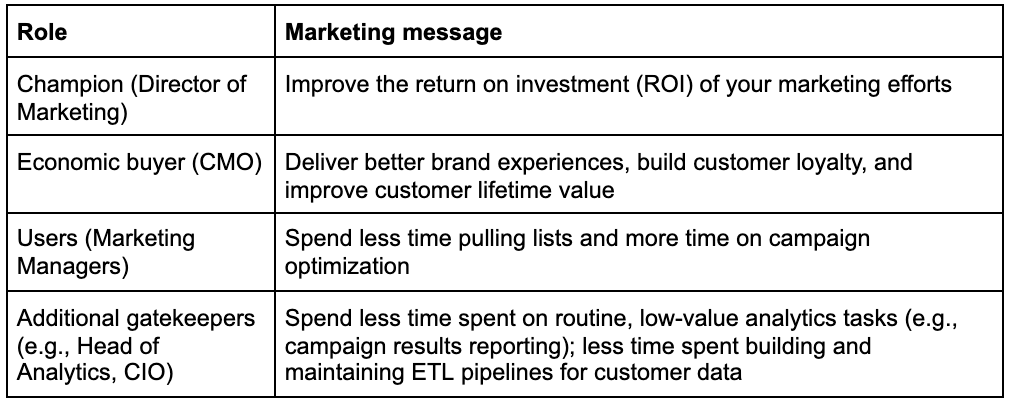Ah, the enterprise client. For a B2B startup, it’s the ultimate dream: a tech stack likely ripe for disruption, a plum contract size, and an incredible logo.
But marketing and selling to an enterprise can quickly become a black hole of time and resources for an early-stage company. The number of decision-makers and complexity of the buying process spook many startups into steering clear altogether.
Landing an enterprise deal requires a concerted strategy, along with the discipline and patience to see it through. Here’s how to do it right.
Develop a nose for desperation (i.e., find the right buyers)
You know the saying “Nobody gets fired for buying IBM?” Organizations tend to become more risk-averse as they grow – they’re increasingly accountable to large customer bases, investors, and in some cases public markets. And a complex organizational structure and buying process often reinforce a preference for incremental change rather than big swings for the fences.
Think about it from the perspective of a potential buyer in the enterprise: here you are coming in as a (mostly unproven) startup, trying to potentially displace an incumbent technology or get someone to roll the dice on a new tech category. Only a desperate person would make that tradeoff.
And that’s exactly who you should target: truly desperate buyers. What does the profile of desperation look like? Well, here are a few examples:
- A bank that’s getting leapfrogged by digitally-native competitors
- A retailer that’s struggling to go direct-to-consumer
- A telecomm with industry-lagging customer satisfaction
These are your people. These are the organizations that are experiencing so much pressure that they’re willing to accept a high-risk/high-reward tradeoff.
The good news is that it’s not hard to identify organizations where someone is in the hot seat to deliver results. For public companies, pay attention to earnings calls and public statements. For private companies, scour press coverage looking for personnel turnover or a major change in strategic direction.
Borrow credibility
Let’s face it: as an early-stage startup, you likely don’t have lots of social proof. Perhaps you have a small handful of design partners, or a few reference customers. But in order to convince an enterprise that you’re more than just vaporware, you’re going to need additional credibility. And you don’t (yet) have the budget for Super Bowl ads.
Here are some ways to “borrow” legitimacy from external sources until you’ve earned it yourself:
- Trusted industry experts. Having a client tell your brand’s story is great – but best of all is when a neutral third party substantiates that claim. This is why we’re big fans of commissioned third-party research (like the Forrester Total Economic Impact report). Depending on your category, it’s often one of the highest-ROI investments that an early-stage startup can make.
- Non-customer thought leaders. Creating a forum for thought leaders from outside your company (and customer base) is not only one one of Blue Seedling’s hacks for content on a budget – it’s a great enterprise play. Their association with your brand will legitimize and uplevel you. Customer success platform Catalyst is an example of a brand that’s done a brilliant job with their podcast NPS I Love You, which brings in executive leaders from LinkedIn, Looker, Slack, and more.
- Investors. Don’t overlook the importance of leaning on your investor roster and funding status as part of your pitch. It’s a proxy of market traction, and a signal that often matters to enterprise buyers of early-stage software.
Target multiple personas
One of our favorite articles on marketing strategy is this little gem. It highlights the importance of creating “tension” in your marketing positioning by crafting different messages suited to the needs, aspirations, and worldviews of different customer segments.
If you’re selling a software license of reasonable annual contract value (ACV), chances are that you’re going to have at a minimum the following stakeholders in the room:
- Your champion
- The economic buyer (their boss or boss’s boss)
- The actual users of the software (may or may not include the champion)
- Additional gatekeepers, who may be supporters or detractors

Each of them requires a crisp and compelling marketing message. For example, let’s imagine that you’re a startup in the customer data platform (CDP) space – your technology unifies and analyzes customer data. How might you craft a marketing message for each stakeholder in the sale? It requires you to understand the pain points and ambitions of each individual:
You don’t necessarily need dedicated areas of your website for each persona (although if you do, again the brilliant Tom Tunguz provides insight into how to do it right). But be prepared with slides and collateral that articulate your value proposition to each.
Remove friction in the buyer journey
As highlighted above – enterprise sales are complex, typically involving numerous stakeholders (and gatekeepers). Even once you find a champion, chances are that she will then have to sell your solution many times internally.
The most effective way to make life easy for your champion is to over-invest in “artifacts” (i.e., stuff) that they can share as part of the internal sales process. This might include marketing collateral like:
- A white paper on your machine learning approach security protocols, or data privacy policies
- Reference architecture showing where you fit in the enterprise’s technology stack
- Client-friendly documentation of your integration requirements
- A one-pager outlining your team’s approach to customer success
Many early-stage startups (understandably) find this maddening: “What, we really need a document to explain something that could be shared in a 5-minute phone call?”
But again, remember that what you’re really doing is empowering your champion to tell your story and sell on your behalf.
Seek strength in numbers
The nuances of an enterprise partner strategy are outside the scope of this piece (stay posted for a future blog post on the topic!) – but in brief, joint marketing campaigns with partners are a great tactic for gaining enterprise traction:
- They help you appear larger than you are
- They present your offering as part of a larger solution ecosystem
- Depending on the partner, they can help reach different personas within the buying team
Here’s an example of a well-executed partner marketing strategy from one of our clients.
When developing partner marketing campaigns, “quality over quantity” should be your mantra. A single partner with strong brand recognition in your target verticals/personas and a complementary marketing message will outperform multiple partners with questionable fit.
The bottom line
Cracking the enterprise sale may seem daunting for early-stage startups. But understanding and planning for the complexity of the buying process – and empathy for the challenges your champion will face in making your case internally – can help accelerate you towards enterprise success.








